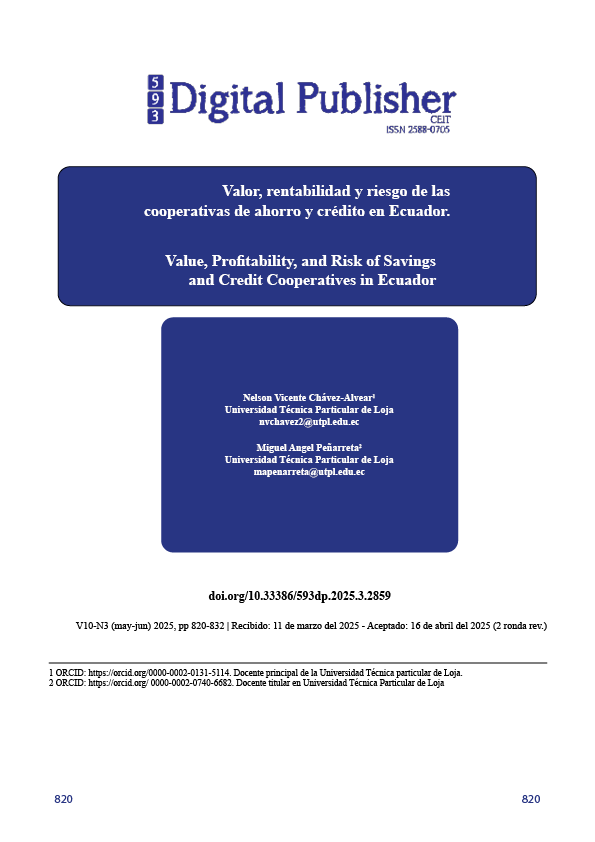Value, Profitability, and Risk of Savings and Credit Cooperatives in Ecuador
Main Article Content
Abstract
The objective of this study is to analyze the relationship between value, profitability, and risk of segment 1 credit cooperatives in Ecuador during the period 2017 to 2024. The methodology employs a quantitative approach based on financial data obtained from the Superintendence of Popular and Solidarity Economy of Ecuador. Econometric models, including linear regression and collinearity analysis (VIF), were applied to measure the impact of variables such as return on investment (ROIC), weighted average cost of capital (WACC), indebtedness (END), liquidity (LIQ) and asset size (LNACT) on the creation of economic value added (EVA). The results show that ROIC is the main determinant of EVA, while CCPP and END negatively affect value generation. Liquidity has no significant impact, and asset size is positively associated with value creation. The implications of the study suggest that COACS management should prioritize strategies to maximize profitability (ROIC) based on revenue diversification and operating efficiency, reducing administrative expenses and credit risks. Optimizing the financing structure would decrease the CCPP and the negative impact on value creation (EVA).
Downloads
Article Details

This work is licensed under a Creative Commons Attribution-NonCommercial-ShareAlike 4.0 International License.
1. Derechos de autor
Las obras que se publican en 593 Digital Publisher CEIT están sujetas a los siguientes términos:
1.1. 593 Digital Publisher CEIT, conserva los derechos patrimoniales (copyright) de las obras publicadas, favorece y permite la reutilización de las mismas bajo la licencia Licencia Creative Commons 4.0 de Reconocimiento-NoComercial-CompartirIgual 4.0, por lo cual se pueden copiar, usar, difundir, transmitir y exponer públicamente, siempre que:
1.1.a. Se cite la autoría y fuente original de su publicación (revista, editorial, URL).
1.1.b. No se usen para fines comerciales u onerosos.
1.1.c. Se mencione la existencia y especificaciones de esta licencia de uso.
References
Ahamad, S., Al-Jaifi, H. A. A., & Ehigiamusoe, K. U. (2023). Impact of Intellectual Capital on Microfinance Institutions’ Efficiency: the Moderating Role of External Governance. Journal of the Knowledge Economy, 14(2), 691–717. https://doi.org/10.1007/s13132-022-00937-8
Ahmadyan, A., & Khansari, R. (2018). Application of Economic Value Added in the Banking Sector of Iran. Journal of Money and Economy, 13(3), 291–318.
Avila, M. S., Ordoñez, Y., & Abril, X. (2024). Incidencia del riesgo financiero y la rentabilidad de las cooperativas de ahorro y crédito del segmento 2 de la ciudad de Cuenca, periodo 2021-2023. LATAM Revista Latinoamericana de Ciencias Sociales y Humanidades, 5(2), 858 – 874–858 – 874. https://latam.redilat.org/index.php/lt/article/view/1920
Bajus, R. (2023). The impact of the application of the economic value-added method in the food company. Potravinarstvo Slovak Journal of Food Sciences, 17, 972–985. https://doi.org/10.5219/1910
Bardhan, A. K., Nag, B., Mishra, C. S., & Tarei, P. K. (2021). An integrated framework for analysing performance indicators of Indian microfinance institutions: a multi-stakeholder perspective. Benchmarking, 28(9), 2711–2740. https://doi.org/10.1108/BIJ-09-2020-0470
Gujarati, D., & Porter, D. (2010). Basic Econometrics (5th ed.).
Kahihu, P. K., Wachira, D. M., & Muathe, S. M. (2021). Managing market risk for financial performance: experience from micro finance institutionin Kenya. Journal of Financial Regulation and Compliance, 29(5), 561–579. https://doi.org/10.1108/JFRC-02-2021-0014
Kamukama, N., & Sulait, T. (2017). Intellectual capital and competitive advantage in Uganda’s microfinance industry. African Journal of Economic and Management Studies, 8(4), 498–514. https://doi.org/10.1108/AJEMS-02-2017-0021
Lelgo, K., & Obwogi, J. (2022). Effect of Credit Risk Control on Financial Performance of Micro Finance Institutions in Kenya. Strategic Journal of Business & Change Management, 9(4), 357–369. https://doi.org/10.61426/sjbcm.v9i4.2492
León-Serrano, Lady, Aguilar-Bazarán, B., & Ordóñez-Pacheco, Á. (2023). Análisis empírico del impacto de los componentes del PIB sobre el sector financiero popular solidario. 593 Digital Publisher CEIT, 8(3), 149–163. https://doi.org/10.33386/593dp.2023.3.1649
Mia, M. A., Rangel, G. J., Nourani, M., & Kumar, R. (2023). Institutional factors and efficiency performance in the global microfinance industry. Benchmarking, 30(2), 433–459. https://doi.org/10.1108/BIJ-06-2021-0326
Owusu-Antwi, G., Mensah, Lord, Crabbe, M., & Antwi, J. (2014). Determinants of Bank Performance in Ghana, the Economic Value Added (EVA) Approach. International Journal of Economics and Finance, 7(1), 203–215. https://doi.org/10.5539/ijef.v7n1p203
Peñarreta, M., & Chavez, N. (2025). Impacto del Capital intelectual en el desempeño financiero de las instituciones microfinancieras de Ecuador Impacto of Intellectual Capital on Financial Performance of Microfinance Institutions in Ecuador. European Public & Social Innovation Review, 10, 1–18.
Pilay-Majao, A., Chasipanta-Baraja, J., Reyes-Armas, R., & Oña-Sinchiguano, B. (2024). Evaluación del riesgo crediticio y su impacto en el costo de capital de la COAC Sierra Centro Cía. Ltda. 593 Digital Publisher CEIT, 9(4), 470–482. https://doi.org/10.33386/593dp.2024.4.2539
Rehman, S., Khilji, J. A., & Sharif, S. (2023). Risk vs Upside uncertainty: application of quantile regression in investment analysis. Macroeconomics and Finance in Emerging Market Economies, 16(2), 264–284. https://doi.org/10.1080/17520843.2021.1952639
Sigcha-santacruz, A. M., & Reyes-armas, R. A. (2024). Enigmas del entorno político en la gestión financiera del sector cooperativista del segmento 1 a partir del método CAMEL. 593 Digital Publisher CEIT, 4, 483–496.
Singh, K. (2024). Social performance, financial risk and financial performance in microfinance institutions. International Journal of Bank Marketing, 42(4), 672–697. https://doi.org/10.1108/IJBM-01-2023-0005
Superintendencia de Economía Popular y Solidaria (2025). Estadísticas del sector financiero popular y solidario. https://estadisticas.seps.gob.ec/
Tripathy, T., Gil-Alana, L. A., & Sahoo, D. (2015). The effect of intellectual capital on firms’ financial performance: an empirical investigation in India. In Int. J. Learning and Intellectual Capital (Vol. 12, Issue 4).
Tudose, M. B., Rusu, V. D., & Avasilcai, S. (2021). Performance Management for Growth: A Framework Based on EVA. Journal of Risk and Financial Management, 14(3). https://doi.org/10.3390/jrfm14030102
Valdivieso, J., & Guerrero, A. J. (2024). Determinantes Del Desempeño Financiero En Las Cooperativas De Ahorro Y Crédito De Ecuador, 2015-2020. Investigación Económica, 83(329), 54–73. https://doi.org/10.22201/fe.01851667p.2024.329.87540
Worthington, A. C., & West, T. (2001). Economic value‐added: a review of the theoretical and empirical literature. Asian Review of Accounting, 9(1), 67-86.

